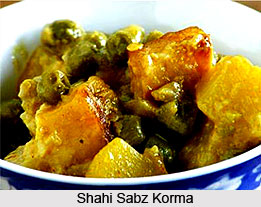 The name Shahi Sabz Korma itself suggests a royal grace with ivory-white appearance and shimmering glaze. The vegetables are carefully chosen so that they will go perfectly with the flavouring. Except for carrots, only light-coloured vegetables are chosen, to blend harmoniously with the almond-yogurt sauce. The vegetables are carefully cut to a uniform size to make them look attractive. This is one of those vegetarian dishes that can be folded into plain cooked rice and transformed into another mouth-watering delicacy, Royal Vegetable and Rice Casserole or the Shahi Sabz Korma.
The name Shahi Sabz Korma itself suggests a royal grace with ivory-white appearance and shimmering glaze. The vegetables are carefully chosen so that they will go perfectly with the flavouring. Except for carrots, only light-coloured vegetables are chosen, to blend harmoniously with the almond-yogurt sauce. The vegetables are carefully cut to a uniform size to make them look attractive. This is one of those vegetarian dishes that can be folded into plain cooked rice and transformed into another mouth-watering delicacy, Royal Vegetable and Rice Casserole or the Shahi Sabz Korma.
Ingredients of Shahi Sabz Korma
•2 medium-sized potatoes (about 250 gram)
•2 medium-sized turnips (about 250 gram)
•1 carrot (about 125 gram)
•12 tbsps ghee or light vegetable oil
•Paneer made with 1 litre milk and are cut in small cubes
•500 gram finely chopped onions
•1 tbsp finely chopped garlic
•1 tbsp finely chopped fresh ginger root
•2 green chilli peppers, seeded and chopped
•12 green cardamom pods
•1 stick cinnamon, 3 inches long
•24 whole cloves
•5 tbsps ground blanched almonds
•250 gram natural yogurt
•60 gram shelled fresh green peas, or frozen peas, defrosted
•1 tbsp salt
•60 ml double cream
Method of Preparing Shahi Sabz Korma
•Peel potatoes, turnips, and carrot and cut them into uniform pieces.
•Heat 3 tbsps oil over medium heat in a large heavy-bottomed pan, preferably one with a non-stick interior. When the oil is hot, add the cheese pieces very carefully. Sauté for about 5 minutes until the Paneer turns lightly coloured on both sides.
•Add the remaining ghee or oil to the pan along with the onions, garlic, ginger and chilli peppers. Increase heat to high, and fry the seasonings for about 10 minutes until they turn light brown. Stir constantly to prevent uneven browning or burning. Add cardamom, cinnamon and cloves, and sauté for an additional 5 minutes. Add ground almonds, stirring rapidly, and fry for 2 more minutes.
•Add 2 tbsps of the yogurt and fry the mixture. When the moisture from the yogurt evaporates, add 2 more tablespoons of yogurt. Continue adding yogurt and frying until the entire yogurt is used up and cook for about 5 minutes. Stir constantly while frying, making sure that the sauce does not burn.
•Drain and add the vegetables. Add the fresh green peas, salt and 375 ml hot water to the sauce. Bring to a boil, reduce heat to medium-low and cover the pan. Cook the vegetables for about 30 minutes until it gets tender but still firm. Add fried cheese pieces, double cream and frozen peas. Cook uncovered, for 10 minutes. The sauce should be thick in this korma. If the sauce is not thick enough, increase heat to medium and simmer until the sauce thickens to the desired consistency. If, on the other hand, the sauce is too thick, add a few tbsps of milk or water.
•Add salt to taste and serve hot. To perk up flavours add ¼ tsp Mughal garam masala.
Shahi Sabz Korma may be served with either bread or rice. Deep-fried puffy bread, whole wheat flaky bread, sweet saffron pilaf, fragrant pilaf banaras style or saffron pilaf with peaches are all good choices. A side dish of buttered black beans goes perfectly with this meal. Fresh mint relish, hot Hyderabad tomato relish and onion relish all go well with Shahi Sabz Korma. Precede the meal with spicy fritters such as cauliflower fritters or onion fritters, or serve fragrant stuffed tomatoes.




















